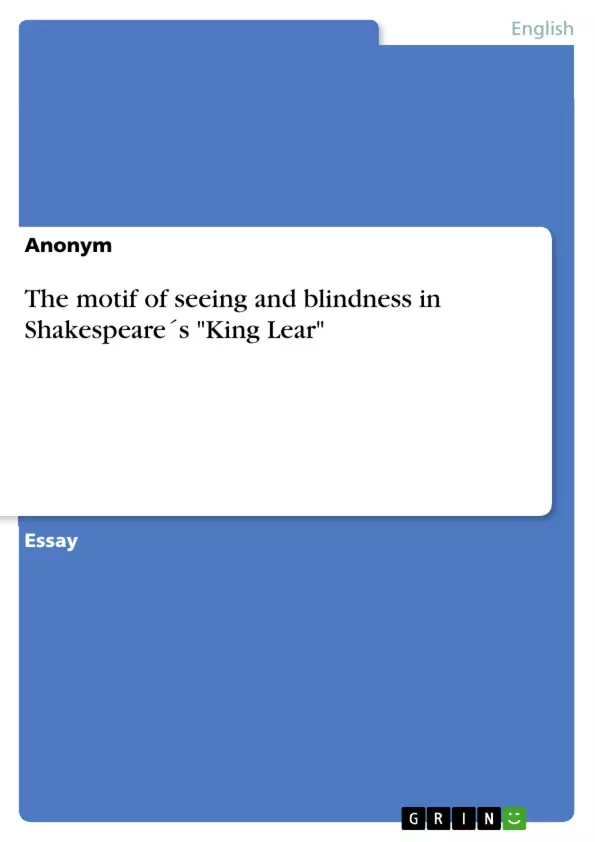In the following this paper wants to show how the motif of seeing and blindness leads through the plot and how those expressions forecast the end of the play "King Lear". In the time period of the English Renaissance the population experiences a transformation that is also visible in literature. Shakespeare uses the family tragedy King Lear, written in the early 17th century, to express morality and other relevant themes. The motif of seeing and blindness is of the utmost significance in this play, for the lack of seeing is responsible for the tragedy.
In total, those “eye-related terms” occur in 142 speeches of the play (Walthall), so even if somebody is reading the play for the first time, he probably suggests that the motif of seeing determines the plot. Emile de Saint-Exupery’s quotation expresses the rhetorical used blindness perfectly. The main characters King Lear and Gloucester both suffer from blindness, mental as well as physical. As a result they are unable to see the love of their children who stay true to them – they are unable to see rightly with their heart. This missing awareness of the heart finally leads to Gloucester´s physical blindness. In terms of Lear, this literally expressed blindness causes his loss of Cordelia and at least his own obliteration. Nevertheless, the both get the ability to ‘see’ clearly again when they are at their lowest.
Inhaltsverzeichnis (Table of Contents)
- The motif of seeing and blindness in Shakespeare's King Lear
- King Lear's blindness
- Gloucester's blindness
- Lear's change in Act III
- Lear's final change and his death
Zielsetzung und Themenschwerpunkte (Objectives and Key Themes)
This essay aims to analyze the motif of seeing and blindness in Shakespeare's King Lear, exploring how this theme shapes the play's plot, characters, and overall message. The essay focuses on the blindness of both King Lear and Gloucester, highlighting the consequences of their inability to see the truth about those around them.
- The significance of seeing and blindness in the play
- The impact of mental blindness on Lear and Gloucester's decisions
- The connection between blindness and the theme of love and betrayal
- The role of the storm scene in Act III in Lear's transformation
- The tragic consequences of Lear's and Gloucester's blindness
Zusammenfassung der Kapitel (Chapter Summaries)
The essay begins by introducing the motif of seeing and blindness in King Lear, emphasizing the centrality of this theme throughout the play. It then examines the blindness of King Lear, arguing that his inability to see beyond words and his stubborn egoism lead to a tragic downfall. The essay further explores the parallel between Lear's mental blindness and the physical blindness of Gloucester, emphasizing the theme of deception and the consequences of misjudging people's true nature. The essay also delves into the importance of the storm scene in Act III, where Lear experiences a pivotal shift in his perception and begins to see the truth about his actions. By examining Lear's final words before he dies, the essay ultimately reveals the tragedy of his blindness and its tragic consequences.
Schlüsselwörter (Keywords)
The essay explores key themes of seeing and blindness, mental illness, love and betrayal, deception, and the consequences of misjudging character. The play's focus on "eye-related terms" and the impact of visual perception on the characters' choices are central to its exploration of the human condition and the complexities of truth and illusion.
- Quote paper
- Anonym (Author), 2017, The motif of seeing and blindness in Shakespeare´s "King Lear", Munich, GRIN Verlag, https://www.grin.com/document/1031707




